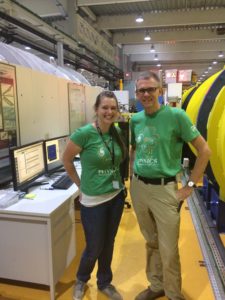University of Notre Dame
Advised by: Professor Morten Eskildsen
 Superconductivity remains a rich and active field a century after its discovery. When exposed to a magnetic field, type-II superconductors become threaded with a periodic array of vortices. This vortex lattice can reveal properties of the host material as well as display novel physics of its own. In the type-II superconductor MgB2, the vortex lattice exhibits several different phases and an unexpectedly robust metastability. Small angle neutron scattering (SANS) provides an ideal probe to study the vortex lattice and search for the mechanism that stabilizes these metastable states.
Superconductivity remains a rich and active field a century after its discovery. When exposed to a magnetic field, type-II superconductors become threaded with a periodic array of vortices. This vortex lattice can reveal properties of the host material as well as display novel physics of its own. In the type-II superconductor MgB2, the vortex lattice exhibits several different phases and an unexpectedly robust metastability. Small angle neutron scattering (SANS) provides an ideal probe to study the vortex lattice and search for the mechanism that stabilizes these metastable states.
Historical Background
Superconductivity was first discovered by H. K. Onnes in 1911 while examining the low temperature properties of metals [1]. To avoid the effects of impurities, Onnes studied liquid mercury as very high-purity samples could be obtained through distillation processes. Below a threshold temperature of ∼ 4 K, which would come to be known as the critical temperature Tc, the electrical resistance of the liquid mercury vanished. Soon after, other elemental metals that are easily drawn into wires, such as tin (3.8 K) and lead (6 K), were found to display the same superconducting state. So-called “persistent currents” have been established in superconducting materials and experimentally measured to flow for over two years with no discernible loss in magnitude [2]. Since their initial discovery, the zero-resistance property of superconductors has made them tantalizing for practical applications.
Unfortunately, Onnes’ dreams of a technological revolution based on superconductivity were ruined when it became apparent that the resistance-less state is weakened in a magnetic field. Above some distinct field value, known as the critical field Hc (Hc2) for type I (type II) superconductors, the infinite conductivity completely disappears. Tantalum has the highest critical field of any type I elemental superconductor at a mere 0.1 T [3]. Based on Ampere’s Law, a critical magnetic field implies there will be also be some critical current density Jc, which again limits the superconductor’s usefulness. Later, type II superconductivity would be discovered in many other alloys and metallic compounds with critical temperature and field values that were much more amenable for applications.
Below the critical field, superconductors also exhibit perfect diamagnetism, which is defined by a magnetic susceptibility of χ = −1. This can readily be understood from Lenz’s Law: a changing magnetic field induces an electromotive force to oppose that change. The zero resistance property of superconductors allows for screening currents that perfectly oppose that change in the magnetic field, returning the bulk of the superconductor to the initial value of B = 0.
Just over two decades after the initial discovery, Meissner and Ochsenfeld found that superconductors are more than just perfect diamagnets. Not only can supercon- ductors prevent a magnetic field from penetrating their bulk, they can also expel any magnetic field already present once cooled below Tc. This would come to be known as the Meissner-Ochsenfeld Effect, often abbreviated to the Meissner Effect. In many ways, the Meissner Effect is a more fundamental property of superconductivity than zero resistance. The expulsion of magnetic flux cannot be explained by perfect conductivity as Lenz’s law dictates the magnetic field be constant with time, but not necessarily zero. Furthermore, it establishes superconductivity as a true, thermal equilibrium state as it is independent of the specific thermo-magnetic history. No magnetic flux can penetrate the bulk of superconductors whether the material is cooled through Tc and then subjected to a magnetic field or vice versa. The notable exception to this is the vortex state of type II superconductors. We will return to this point later.
[1] H. K. Onnes. Further Experiments with Liquid Helium. D. On the change of the Electrical Resistance of Pure Metals at very low Temperatures, etc. V. The Disappearance of the resistance of mercury. Communications from the Kamerlingh Onnes Laboratory of the University of Leiden, (No. 122b):81–83, May 1911.
[2] E. A. Lynton. Superconductivity. Wiley, New York, 1969.
[3] J. Eisenstein. Superconducting Elements. Reviews of Modern Physics, 26(3): 277-291, July 1954.
